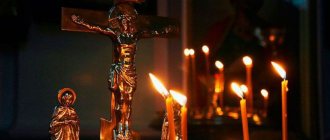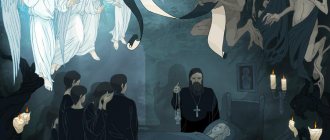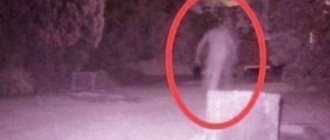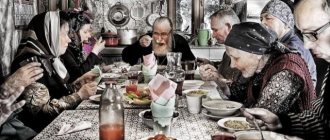- November 23, 2018
- Depressive states
- Oleg Petrov
As sad as it is to realize, every person will die. What awaits us after death interests everyone without exception. Sooner or later, this fate is destined for each of us. Adults have had to deal with the loss of friends and loved ones more than once. Where do their souls go, what will happen to your own soul when the time comes? We will try to answer these questions in this article.
Inevitable death
What awaits us after death? This is a question that interests everyone without exception. Poor and rich, sick and healthy people - everyone dies sooner or later. The bravest may claim that they do not know the fear of death, but as soon as such a prospect appears on the horizon, they will immediately change their attitude towards this problem.
In our country, until quite recently, the overwhelming majority of the population had an atheistic upbringing; the majority knew for sure what awaited us after death. They were convinced that this was the final stage for any living organism. Man is no exception.
At the same time, the church taught exactly the opposite point of view, claiming that death does not exist for humans. Our soul is immortal, the whole question is where it will end up when the time comes to die: in heaven or in hell.
After the collapse of the USSR, discussions about what awaits us after death only intensified. Being an atheist has become unfashionable; new questions arose for every citizen who tried to understand this issue. Because of the “Iron Curtain,” a wave of the most diverse religious, and sometimes simply mystical, information literally poured out on everyone. Sects with exalted pastors began to appear en masse, some were carried away by the Hare Krishnas, others believed in Jehovah's Witnesses.
In our time, for a person to believe in life after death, he needs to provide irrefutable evidence, and science is considered the most authoritative in this matter, although initially its adherents were mainly atheists who used it to promote their ideas. In recent years, medical research has increasingly demonstrated that after the death of the body, our “I”, the personality, does not die, but continues to exist in fundamentally new conditions.
The value of life
It is believed that man's greatest fear is the fear of death. But why be afraid of what will happen anyway? Understanding that death will one day knock on our door can help us conduct a deep revision of our values.
And if you want to change your life, then you shouldn’t wait for the right time. Act now >>>
Knowing that one day this journey will come to an end, we can appreciate what we have more. The ability to love, give warmth to loved ones, cry from pain and laugh from joy, and even enjoy a cup of coffee in the morning is a huge gift of life. Let's live in such a way that one day God will look at us and say: “Perhaps you will remain on earth for a couple of centuries?”
"Transition"
In particular, Peter Kalinovsky presents interesting thoughts about what happens to the soul after death in his book “The Transition.” He notes that modern methods of resuscitation have allowed doctors to lift the veil of the mystery of death, bringing recently deceased people back to life. Now they are able to see much more than they saw before.
Today, many scientists authoritatively declare that the death of the body does not mean the complete end of the existence of the individual, therefore it is quite possible to believe in life after death. The researchers were simply amazed by the results they arrived at, having initially met them with bewilderment and even disbelief. As a result, it turned out that the new data are not the fruits of fantasy, but indisputable facts confirmed by science. Unlike the Christian idea of the world, based solely on the belief in what happens to the soul after death, here we have to deal with indisputable facts, documented.
By the beginning of the 21st century, more than two and a half thousand documented testimonies of patients who experienced clinical death had already accumulated. In particular, they stated that they visited another reality at a time when their heart stopped beating. A large amount of evidence, their similarity, as well as the same eyewitness testimony allow us to assert that the death of the physical body does not limit a person’s life.
2. Fourteen planes of existence in the Universe
There are 14 zones in the Universe, of which seven are positive and seven are negative. The negative zones are known as Hell (Patala). There are also several subzones within the main zones.
According to the great Indian Saint, Sri Adi Shankaracharya (8th-9th century) Righteousness ( Dharma
)
this is something that performs 3 tasks: 1. Preserves the social system in the best possible way 2. Brings world progress to all living things 3. Causes progress in the spiritual sphere - Sri Adi Shankaracharya
Seven positive zones. Mainly occupied by living people and subtle bodies after death performing righteous deeds and engaging in spiritual practice in accordance with the positive path of spiritual practice. These zones are also known as the seven positive areas or saptaloks. By positive path we mean if spiritual practice is oriented towards God realization, which is the ultimate goal of spiritual growth.
The Earth level is the only gross (physical) level in the Universe and the first positive level among the seven positive zones.
Seven negative zones: They are occupied mainly by subtle bodies that have committed unrighteous acts and are engaged in spiritual practice in accordance with the negative path. By the negative path we mean the orientation of spiritual practice towards the achievement of spiritual power, such as supernatural powers. This spiritual power is mainly used to increase control over others or for negative purposes. Thus, all subtle bodies that fall into any of the planes of Hell become ghosts due to their evil intentions.
Refer to the article: 'Who are ghosts?'
Each zone of Hell (Patala) has subzones (Naraki). For example, the first level of Hell will have a subzone called the first Naraka, it is dedicated to the worst of the ghosts (demons, demons, negative energies, etc.). They undergo a more severe and longer punishment there than in the main Hell zone.
Life continues after death either in positive or negative zones of existence.
Note:
1. For the sake of simplicity, although we have shown the zones one above the other, in reality they are all located in the same space. The earth is the only gross (physical) zone, other zones are more subtle and invisible to material vision. In fact, different people, although living on Earth, experience thoughts and emotions corresponding to different zones according to their spiritual level or thoughts. For example, Saints, that is, spiritually developed people above 70% of the spiritual level, lead a life corresponding to the positive zones of Heaven and beyond. On the other hand, a person planning a theft experiences thoughts corresponding to the 1st zone of Hell; a person planning some action aimed at causing harm to others, the 2nd zone of Hell, and so on. A person planning a murder experiences thoughts corresponding to the 7th zone of Hell. However, no 2 zones can be experienced simultaneously, that is, a person cannot experience thoughts corresponding to 2 different zones, such as Heaven and Mahaloka.
2. Purgatory (Buvaloka) is actually located far from God. However, we have depicted it as a positive zone because after death, subtle bodies from this area still have the opportunity to be born on Earth to grow spiritually. But if the subtle body falls into one of the zones of Hell, then it has little chance of being born on Earth and moving towards God.
Color Scheme Explanation
- The earth is depicted in reddish color as it represents action (the main subtle component of Raja). This is the only physical zone where we have a physical body to do anything.
- Heaven is depicted in pink, symbolizing abundance and happiness.
- The color yellow symbolizes spiritual knowledge and the increase in the basic subtle component of Sattva. Finally, at the highest stage it becomes almost white, which represents proximity to the unmanifested Divine Principle.
- The Hell zones are represented by darker shades to black, as they are dominated and increased by the subtle basic component of Tama.
For more details on Sattva, Raja and Tama, see section 6 below.
Foreign studies
Books describing posthumous experiences became popular in the West back in the 70s of the last century. Their authors were reputable doctors and scientists, for example, expert on the problems of dying and death Elisabeth Kübler-Ross. In her opinion, research data on post-mortem experiences prove that life after death awaits us, albeit in a different form. In particular, her findings are confirmed by the work of Haraldson and Osis.
One of the first scientists who began to closely study what awaits after a person’s death was Dr. Raymond Moody. In 1975, he published the book “Life after Life,” which was devoted to the study of the so-called phenomenon of the continuation of life after the physical death of the body. Two years later, another of his works appeared - “Reflections on Life After Life.” These books gave many examples of people who were in a state of clinical death.
In particular, in these stories, patients stated that they often felt how their heart stopped beating, how they left their body. They began to hover near the ceiling, watching as nurses and doctors tried to carry out resuscitation measures. At the same time, they were completely calm, not understanding why everyone around them was so worried when the person himself felt great.
Characteristics of positive zones in the Universe
| Levels of the universe¹ | Spiritual level % | Share of sattva component | Type of person | Predominant body6 | Predominant emotion |
| Satyaloka | 90 | 95 | Almost completely knowledgeable | Subtle ego / Supercausal | Sattvic happiness (5%) Bliss and Peace (95%) |
| Tapaloka | 80 | 90 | Very knowledgeable | Intelligence/Causal | Sattvic happiness (25%) Bliss and Peace (75%) |
| Janaloka | 70 | 85 | More knowledgeable | Intelligence/Causal | Sattvic happiness (50%) Bliss and Peace (50%) |
| Mahaloka | 605 | 80 | Knowing | Intelligence/Causal | Sattvic happiness 9 (75%) Bliss and Peace (25%) 10 |
| Upper Paradise | 50 | 75 | More merit | Intelligence/Causal | More happiness |
| Lower Paradise | 404 | 60 | Less merit | Mental body or mind | Less happiness8 |
| Purgatory (Bhuvaloka)2 | 25 | 40 | Average | Desires, part of the mental body | Misfortune 7 |
| Earth | 203 | 33 | Average | Physical | Happiness/Unhappiness |
Note (to the table):
- Each of the positive and negative zones outside the Earth is becoming thinner and thinner. By "subtle" we mean that they are beyond the understanding of the five senses, mind and intellect. Satyaloka is the subtlest zone, and therefore it is very difficult to perceive and understand unless the highest level of the sixth sense (ESV) has been achieved.
- Due to lack of spiritual practice and more sins, most people in the current era go to either Purgatory or one of the Hell zones after death. We usually go to Purgatory after death when the percentage of sins (due to wrong actions on Earth) is approximately 30%. Sins usually include evil intentions towards others and many desires. In Purgatory, there is a very high chance of being attacked by higher level ghosts from the lower areas of Hell.
- Earth is the only place of existence where people of different spiritual levels are together. Therefore, after death, everyone goes to the zone that corresponds to his level.
- The minimum spiritual level required to achieve Heaven in life after death is 40%. Please refer to the article which explains what spiritual level is and gives the 2016 distribution of the world's population based on their spiritual level. This breakdown is valid until the coming Third World War. Basically from the point of view of Spiritual Science, the actions through which we can reach Heaven or the higher positive zones of existence in the afterlife are actions done without expectation with the goal of realizing God. The following three criteria can be applied in life after death: - Actions performed without the feeling that 'I am the doer', that is, with the perspective that God himself is doing it through me, and therefore I cannot appropriate the fruits to myself. – Actions performed without expectation of approval or appreciation. – Actions taken without expecting results. More than the actions themselves, what matters is the attitude or worldview behind the actions. It is important to note that the subtle bodies, at about 40% of the spiritual level in life after death, are often pulled back by negative energies and therefore remain in Purgatory.
- To reach areas above Heaven, one must reach a spiritual level above 60%. This is possible only through continuous spiritual practice in accordance with the six principles of spirituality along with serious reduction of the ego.
- By the dominant body we mean the body that is more active, that is, the mind, intellect and subtle ego. For example, in Purgatory, the subtle bodies still have many desires and attachments. As a result, they often become ghosts trying to fulfill some wish of theirs through their descendants or people on Earth. This weakens them and allows stronger ghosts from the lower zones to take control of them, using their passionate desires to influence people on Earth.
- In Purgatory, subtle bodies experience only misfortune, since their desires cannot be fulfilled.
- In Paradise, subtle bodies experience an overabundance of happiness. It far surpasses happiness on Earth in quality, quantity and duration. The higher the level of the positive zone, the higher the quality of happiness and the absence of unhappiness.
- Sattvic happiness means that happiness that we acquire in the process of helping others without expectation. When the ego is involved, it becomes rajasic.
- Peace is a higher spiritual state than Bliss.
3.1 Positive Zones and rebirth on Earth
After death, from the subtle zones below Mahaloka, people must be reborn on Earth to complete their destiny and work off their karmic accounts. If after death a person reaches higher regions such as Mahaloka or Janaloka due to a higher spiritual level, he does not need to be reborn on Earth, since the entire remaining destiny of the person (accumulated account) can be worked out in these zones. However, these developed subtle bodies in their life after death can choose to be born of their own free will. They do this because of their expansive nature, primarily to act as spiritual guides for humanity and to help society grow spiritually.
In some cases, people even below the spiritual level of 60% can achieve Mahaloka. It examines a person's potential for further spiritual growth in the afterlife. Through spiritual research we have discovered that there are 5 factors that influence this potential for further spiritual development.
- High level of spiritual emotion (bhav)
- Low Ego
- A strong desire for spiritual growth
- Do regularly spiritual practice of increasingly higher levels
- The influence or lack of influence of negative energies. If a person is possessed or influenced by negative energies, it can seriously hinder the ability to grow spiritually. In the afterlife, such affected subtle bodies, even if they are at the spiritual level of 60%, can be blocked by negative energies to reach higher subtle regions of the Universe.
3.2 Importance of the existence of the Earth zone
Land is very important. This is the only area where we can gain rapid spiritual growth and settle our karmic accounts in no time. The reason is that through the physical body we can do a lot to accelerate our spiritual growth, increase our spiritual level and reduce the underlying subtle component of Tama.
Except on Earth, spiritual growth after death is likely to occur only in areas outside of Heaven, such as Mahaloka, etc. This is because in Heaven, subtle bodies risk falling into the endless pleasures that Heaven offers. The punishments in Purgatory and Hell are so severe, as well as the attacks from other higher level ghosts, that it becomes very difficult to cope with it in order to undertake any quality spiritual practice.
Skeptical view
Of course, not everyone unconditionally believes in what happens to a person after death. There are quite a lot of skeptics who claim that this may be a figment of the imagination of a diseased brain or the most common hallucinations.
However, these statements are quite easy to refute. The fact is that patients often talk in detail about events that they physically could not see. For example, while remaining in the operating room in a state of clinical death, they talked about what was happening in other areas of the hospital.
It is also important that the very moment of death or transition to another existence is never associated with pain and suffering. After all, many fear death precisely for this reason. They are not so much afraid of what awaits a person after death as they are afraid of not being able to endure mortal suffering.
In fact, as practice shows, everything happens exactly the opposite. Especially if a person is seriously ill before death, at the moment of death he experiences great relief. So the phrase that death relieves suffering actually reflects what happens to a person after death.
The same Kalinovsky notes that the transition sometimes occurs so imperceptibly that the deceased does not immediately realize it, continuing to consider himself alive. Having crossed a certain threshold, he continues to hear and see people, but when he tries to tell them something, to at least somehow attract their attention, he convinces them that they do not notice him.
How do ghosts manifest themselves?
Supporters of esoteric teachings believe that being “stuck” between the worlds after 40 days, the soul sometimes gives signs from there to the living. They may have the following manifestations:
Parking the car under a street lamp: simple ways to park with burglary protection
A cup of coffee, a walk to work: changes in daily routine reduce the risk of dementia
Paris Hilton and Lanvin: The model tried on classic minimalist looks
- visits to a loved one in a dream;
- calls from various unidentifiable numbers, noise on the phone;
- sensation of presence, touch;
- reflection in the mirror;
- unexplained images in the photo.
Such cases indicate that the spirit of the deceased is trying to convey something important, perhaps to prevent some undesirable event. And he can also ask for help in the transition to eternal life. In such situations, you need to pray, remember the departed with a kind word and lead a decent life.
Stages
If we summarize everything that is known about what happens after death, we can come to the conclusion that our soul goes through several stages. The first thing that happens to the deceased is leaving the body. He begins to exist separately from her, without losing consciousness. At the same time, a person often retains the ability to see everything that surrounds him, even his dead body, as well as doctors’ attempts to bring him to his senses.
In this state, he can feel painless lightness and warmth, as when swimming. At the same time, he is not able to influence the environment with any touch or voice. As a result, a feeling of loneliness appears and thought processes become more active.
The second stage involves meeting others. In the original state of loneliness, the soul remains very little. Dr. Moody gives examples where, even shortly before death, people suddenly began to see their relatives and friends who had long since died in the real world.
Analyzing the experience of people who have experienced clinical death, it is worth noting that there is a big difference between the experience of dying people and the death of Orthodox Christians. Christian theologians have recently argued that the creatures with which people try to come into contact at spiritualistic séances are actually demons, and not the souls of the dead. Everyone who has studied spiritualistic phenomena in any detail has come to such conclusions. So it is possible that the images of friends and relatives that a person sees immediately after death are otherworldly evil spirits. Only saints appear to righteous people, but most of us are sinners, so we should not immediately trust the beings we see at that moment. Such encounters usually occur immediately before death, but should not be confused with an encounter with a so-called “luminous being” that occurs later.
What do people who have near-death experiences say about the soul?
To better understand where the soul goes after death, you can listen to the stories of people who once experienced a state of clinical death, that is, “stood on the threshold of the next world.”
This happens from time to time all over the world; doctors in hospitals every now and then have to record cardiac arrest and cessation of the functioning of other organs in patients. But after this the person suddenly returns to life again.
Subsequently, the stories of people who have had near-death experiences (NDEs) are amazing and cause very mixed feelings.
The most common memory is the moment when the soul leaves the body. Many people describe how they saw themselves as if from above, and watched the actions of doctors (if they were in a medical facility at that time).
Further, the same light at the end of the tunnel is often mentioned. People who have experienced clinical death claim that this “corridor” really exists, and it is along it that the souls of the dead move.
Describing their feelings, having been “there”, they unanimously speak of amazing lightness, carelessness and all-consuming Divine love. There is no physical suffering, pain, only happiness and the opportunity to communicate with the Almighty.
The soul, most often, does not want to return to the body, but returns, obeying the strict order of a higher voice, which knows that the time of final death has not yet come.
It also happens that the soul returns to the body because it does not want to allow loved ones who love the person who is on the verge of death to suffer.
There is also this observation: after death, the soul not only leaves the body, but can instantly appear in any place that is dear to a person.
Dr. Raymond Moody, in his book Life After Life, collected the memories of people who had near-death experiences. Here are some of the descriptions:
- I believe that this experience (clinical death) was defining for me. I was little when this happened – it all happened at the age of 10. But I am still completely confident in the existence of life after death. I don’t even doubt or fear death.”
- “Now I'm not afraid to die. Of course, I don't have a death wish right now. I want to live here in this world. But I’m not afraid to die, because I understand what will happen to me when the time comes.”
- “Life is like imprisonment. But being here on Earth, we don’t realize this, we don’t understand that the body is our prison. Death is tantamount to leaving prison, it is liberation.”
- “As a child, I often feared death. Sometimes it came to panic - hysterics, tears. Having experienced an NDE, I am no longer afraid of dying, the fear has completely disappeared. I stopped feeling sick at funeral ceremonies.”
"Luminous Creature"
When telling what will happen after death, most people compare this state with the appearance of light, the brightness of which increases very quickly. Almost everyone recognizes him as a certain person who is filled with love and warmth, moreover, to whom the deceased has an attraction comparable to magnetic attraction.
Everyone identifies this creature differently, with religious preferences playing a decisive role. It can be stated unequivocally that it does not have any clearly recognizable shape.
Eyewitnesses say that when they heard from the doctor about their death, they felt as if they were starting to sink or swim somewhere. There was complete darkness all around, except for this bright source of light that could be seen in the distance. As it approached him, it constantly increased in size. Some managed to float into this crystal clear and pure light, which immediately began to be associated with perfect love and understanding of everything that was happening in the world.
Some who know what awaits us after death, or at least claim it, talk about angels, emphasizing their positive qualities. They are full of love, inspire responsibility for their lives, and are kind. It is impossible to establish for certain whether these are really angels. At least from what is known about them in Christianity, it can be concluded that they must be more defined in function and appearance.
Not much credible evidence has come down to us about encounters with angels. Since very few people reached this contact, who were then able to return. Most returned to their body much earlier.
From famous stories it is known that a deceased person is usually greeted by two angels. They have a human or similar appearance, in contrast to the “luminous creature”, which does not accompany the soul, but draws it into conversation, showing footage of the life it has lived.
Communication among the dead
Communication is especially different in that world. If here we can use speech and writing, then there everything is much more complicated. Since this is a subtle plan, the main means of communication becomes the intention to do something. Thoughts and images are instantly transmitted to the recipient.
Because of this, conversations in the usual sense cease to exist, giving way to more effective communication. The openness and impartiality of all interlocutors is so obvious that their discussion of any topic does not cause serious difficulties.
Air ordeals
In theological literature one can find many descriptions of what happens to the soul after death. Together with the angels, she has to overcome the cordons of demons, answering for every unseemly act or sin committed in real life. A popular subject in Orthodox iconography is the aerial ordeal of Blessed Theodora. Similar icons can be found in many churches, but this example is not the only one.
The Anglo-Saxon priest Boniface in the 8th century retells the story of a monk who managed to return to life a few hours after his death. If you believe him, he was able to continue living after death. His soul was taken up by angels who were so beautiful and bright that he simply could not look at them. Next, a fierce dispute for the soul began between the angels and evil spirits. Demons aggravated the sins committed, and the Angels sought to soften them, to lighten this burden.
In the Orthodox tradition, going through aerial ordeals is a stage of an honest trial, with the help of which it is decided where after death the soul can go - to hell or to heaven.
What is heaven - the abode of God?
For example, at the end of December 1994, astronomers managed to decipher images taken using the Hubble telescope. A tiny speck in one of the images caught the attention of Professor Ken Wilson from the University of Florida.
Having examined it with a magnifying glass, the scientist found out that the structure of the fragment was unlike anything previously seen. It was decided to re-shoot this area of star clusters with the highest available resolution. The new images shocked all astronomers. They could clearly see something very similar to a huge shining city of unimaginable size. Next to it, our planet would be no larger than a grain of sand.
Using powerful computers, scientists analyzed the structure, called the “Abode of the Creator,” and found out that all known galaxies begin their path from it. In addition, it turned out that the universe as a whole revolves around this cosmic paradise.
The Hubble web server was open to access at that time. The initial information received was scattered throughout the world. Then NASA restricted access, and further research became classified. And it is unlikely that we will soon be able to find out their details.
Clinical death
Interestingly, there is a different point of view in the scientific world. When discussing the similarity of near-death experiences, some researchers explain them from the point of view of pathological physiology, since similar processes occur in the brain of a person in a state of clinical death.
Some psychiatrists claim that, based on the research conducted, it can be argued that all these visions are not evidence of life after death, but rather a revelation of the dissociative hallucinatory activity of our brain. This position also exists.
In 2014, large-scale research was carried out, the result of which was the conclusion that, despite the fact that this experience is perceived by many as hallucinations and illusions, in reality it may well be combined with reality. Moreover, there was a documented case where one of the experiment participants remained conscious after turning off the brain for at least three minutes. In this regard, scientists come to the conclusion that in this case, manifestations of consciousness are likely in patients in whom it cannot be detected by clinical methods.
Among American neurosurgeons, a fairly popular version is that consciousness itself does not depend on the brain, and the death of a person is only a transitional stage to another sphere. This hypothesis is advanced by Alexander Eben, whose work is based on a personal near-death experience that he experienced while plunging into a coma. In the future, he wrote several books, the neurosurgeon actively lectured in hospitals and churches around the world, spoke at academic symposiums, in higher education institutions, and regularly appeared on television shows.
From the point of view of parapsychology, these near-death experiences are considered as evidence of the possibility of the existence of life after death. The bulk of research indicates that people do not remember anything about the shock they experienced before death. At the same time, there are quite a lot of those who claimed to be able to consciously describe all their experiences. Reputable parapsychologists say that decades of study of near-death experiences have not led them to a generally accepted explanation of what is happening, even among those who have done very careful work. The burning question facing researchers today is how these experiences can be explained.
At the same time, hellish near-death experiences are present, although they occur in no more than 15 percent of patients. It is quite difficult to assume their truth; for example, it is believed that suicides should experience them, but in reality nothing like this happens to them. But the so-called “heavenly experiences” significantly reduce the likelihood of attempting suicide again. For example, in a review by English psychologist Susan Blackmore, there is a mention of a 72-year-old cancer patient who fell into a state of clinical death after an overdose of narcotic analgesics. For him, near-death experiences were very pleasant, which may be due to the influence of morphine.
Is it true that dead people can see us?
To answer whether deceased relatives and other people see us, we need to study different theories about the afterlife. Christianity talks about two opposite places where the soul can go after death - heaven and hell. Depending on how a person lived, how righteously, he is rewarded with eternal bliss or doomed to endless suffering for his sins. According to esoteric theories, the spirit of the deceased has a close connection with loved ones only when he has unfulfilled tasks.
In the memoirs of the holy confessor Nicholas, Metropolitan of Alma-Ata and Kazakhstan, there is the following story: Once Vladyka, answering the question of whether the dead hear our prayers, said that they not only hear, but “they themselves pray for us. And even more than that: they see us as we are in the depths of our hearts, and if we live piously, they rejoice, and if we live carelessly, then they grieve and pray to God for us. Our connection with them is not interrupted, but only temporarily weakened.” Then the Bishop told an incident that confirmed his words.
The priest, father Vladimir Strakhov, served in one of the Moscow churches. After finishing the Liturgy, he lingered in the church. All the worshipers left, only he and the psalm-reader remained. An old woman enters, modestly but cleanly dressed, in a dark dress, and turns to the priest with a request to go and give communion to her son. Gives the address: street, house number, apartment number, first and last name of this son. The priest promises to fulfill this today, takes the Holy Gifts and goes to the indicated address.
He goes up the stairs and rings the bell. An intelligent-looking man with a beard, about thirty years old, opens the door for him. He looks at the priest somewhat surprised.
- “What do you want?”
- “They asked me to come to this address to see a patient.”
He is even more surprised.
- “I live here alone, there is no one sick, and I don’t need a priest!”
The priest was also amazed.
-"How so? After all, here is the address: street, house number, apartment number. What is your name?" It turns out that the name is the same.
- “Allow me to come in to you.”
- "Please!"
The priest comes in, sits down, says that the old woman came to invite him, and during his story he looks up at the wall and sees a large portrait of this same old woman.
- “Yes, here she is! She was the one who came to me!” - he exclaims.
- “Have mercy! - the owner of the apartment objects. “Yes, this is my mother, she died 15 years ago!”
But the priest continues to claim that he saw her today. We started talking. The young man turned out to be a student at Moscow University and had not received communion for many years.
“However, since you have already come here, and all this is so mysterious, I am ready to confess and take communion,” he finally decides.
The confession was long and sincere - one might say, for my entire adult life. With great satisfaction, the priest absolved him of his sins and introduced him to the Holy Mysteries. He left, and during Vespers they came to tell him that this student had unexpectedly died, and the neighbors came to ask the priest to serve the first requiem. If the mother had not taken care of her son from the afterlife, he would have gone into eternity without receiving the Holy Mysteries.”
Does the soul of a deceased person see his loved ones?
After death, the life of the body ends, but the soul continues to live. Before going to heaven, she stays with her loved ones for another 40 days, trying to console them and ease the pain of loss. Therefore, in many religions it is customary to schedule a funeral for this time in order to escort the soul to the world of the dead. It is believed that ancestors see and hear us even many years after death. Priests advise not to speculate about whether the dead see us after death, but to try to grieve less about the loss, because the suffering of relatives is difficult for the deceased.
Can the soul of the deceased come to visit?
The religion condemns the practice of spiritualism. This is considered a sin, since a tempting demon may appear under the guise of a deceased relative. Serious esotericists also do not approve of such sessions, since at this moment a portal opens through which dark entities can penetrate into our world.
However, such visits can occur on the initiative of those who left Earth. If there was a strong connection between people in earthly life, then death will not break it. For at least 40 days, the soul of the deceased can visit relatives and friends and observe them from the side. People with high sensitivity sense this presence.
The deceased uses the dream space to meet the living when our body is asleep and our soul is awake. During this period, you can ask for help from deceased relatives. He may appear to a sleeping relative to remind him of himself, provide support or give advice in a difficult life situation. Unfortunately, we do not take dreams seriously, and sometimes we simply forget what we dreamed at night. Therefore, the attempts of our departed relatives to reach us in a dream are not always successful.
When the connection between loved ones was strong during life, this relationship is difficult to interrupt. Relatives can feel the presence of the deceased and even see his silhouette. This phenomenon is called a phantom or ghost.
Can a deceased person become a guardian angel?
Everyone perceives the passing of a loved one differently. For a mother who has lost a child, such an event is a real tragedy. A person needs support and consolation, because the pain of loss and longing reign in the heart. The bond between mother and child is especially strong, so children feel suffering acutely. Moreover, any deceased relative can become a guardian angel for a family. It is important that during his lifetime this person is deeply religious, observes the laws of the Creator and strives for righteousness.
Scientific background
If we turn to the latest research, it is important to find completely scientific facts about what awaits us after death. Experts were able to present quite compelling arguments that explain everything that was happening.
In particular, it is recognized by many as a medical fact that people after official death can understand and hear everything that happens around them. Moreover, this has nothing to do with paranormal phenomena. It’s just that a person really continues to live and think for some more time, although instruments may say the opposite.
According to medical indicators, absolute death occurs under one of two conditions: when the heart or brain stops working. In some cases this happens simultaneously. If the brain stops working as a result of serious damage, death occurs immediately as soon as this “central processor” of our body is turned off. But if life is interrupted as a result of some damage that causes the heart to stop working, there are certain nuances.
New York University scientists were able to establish that after death a person can hear people’s speech, smell, and even see with their own eyes. This is not easy to imagine, because becoming someone else after death is not easy for everyone. This precisely explains the phenomenon according to which vision of the world occurs during clinical death. You can often find cases where people recount their feelings while in this borderline state. The same thing happens after death.
The brain and heart are two human organs that work throughout our lives. They are interconnected, but these sensations after death are available only thanks to the brain, which for some time continues to transmit information to our consciousness from the nerve endings.
Psychics and bioenergy specialists have long argued that a person does not die instantly after the heart or brain stops working. Everything is much more complicated, as scientific research confirms. According to experts in the paranormal in our lives, the other world directly depends on the visible and real world.
At the time of death, many argue that a person sees all his past lives, as well as his current one, in every detail, experiencing everything again in a short moment, then turns into nothing, and then is reborn again.
It is noteworthy that a person does not feel pain after death, does not feel grief or joy. He remains to exist in the otherworldly reality, moving to a fundamentally different level. At the same time, no one knows for certain what happens to a person’s soul after death: it passes into another body or simply evaporates, or maybe remains forever in a better world. This remains unknown. It is believed that everyone should listen to what their heart tells them. The main thing is not to argue, because no one will be able to know for sure what is going on with his soul.
What happens after death to a person's soul?
The body of a dying person continues to function for some time. All the most important systems of the body die off gradually, as if giving the dying person the opportunity to realize his fate and come to terms with what happened. For example:
- Blood continues to nourish the organs, albeit less actively.
- For at least a few more hours after his “official” death, a person perceives the world around him.
- The deceased hears conversations, reflects and ponders his current situation.
- He may even try to move his hand, but the body will not obey him.
- Capable of thinking, a deceased person continues to experience emotions.
Realizing his death, he falls into anxiety, which is gradually replaced by a feeling of humility, calm and slow dissolution. Consciousness seems to be “spread out” throughout space, and the soul has absolutely no desire to return to the body. After this, humility turns into pleasure.
Soon a certain entity may appear, the call of which cannot be resisted. There are cases of patients attacking medical staff after they were restored to consciousness. They no longer wanted to face our reality again and preferred to continue the path they had begun.
Soul is a physical object
Of course, the soul cannot be touched, but some scientists claim that its existence has nevertheless been proven. For some reason, immediately after death, a person loses 21 grams of his weight. It is noteworthy that this always happens and under any circumstances.
No one still has an exact explanation for this phenomenon. Some are convinced that this is the weight of the human soul, which at some point leaves the body. In this regard, it can be explained why a person then sees the world around him after his death.
True, for some people this does not matter, since after the soul leaves our body, a person remains completely unreasonable. This may be the reason why no one is able to speak or move their eyes after cardiac arrest.
Life and death are closely interconnected. Many people prefer not to delve deeply into what really happens to a person after death, since no one will be able to find out with 100% certainty anyway.
The connection between the soul and a living person
Followers of religious and esoteric teachings consider the soul as a small particle of Divine consciousness. On Earth, the soul manifests itself through the best qualities of a person: kindness, honesty, nobility, generosity, the ability to forgive. Creative abilities are considered a gift from God, which means they are also realized through the soul. She is immortal, but the human body has a limited lifespan. Therefore, at the end of earthly life, the soul leaves the body and goes to another level of the universe.











